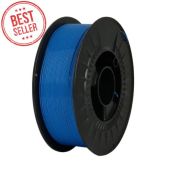We use cookies to make your experience better. Read more
16 April, 2025
ABS vs PLA Filament: Which Is the Better Choice?
When it comes to 3D printing, choosing the right filament is essential for achieving high-quality results. Two of the most popular options are ABS filament and PLA filament. Each has its own unique set of features, benefits, and limitations. In this article, we'll compare these two types of filaments to help you make an informed decision for your 3D printing needs.
Understanding PLA and ABS Filaments
PLA Filament
PLA, or Polylactic Acid, is a biodegradable thermoplastic made from renewable resources such as cornstarch or sugarcane. Known for its user-friendly nature, PLA is often the first choice for beginners and hobbyists.
Key Features of PLA:
- Low Printing Temperature: PLA typically requires a printing temperature between 180°C and 220°C, making it easier to handle.
- Minimal Warping: PLA is less likely to peel or detach from the print bed, even when printing larger objects.
- Eco-Friendly: Being biodegradable and made from renewable materials, PLA is a sustainable choice.
- Smooth Surface Finishes: PLA produces vibrant colors and smooth finishes, making it ideal for decorative items and prototypes.
Applications of PLA:
- Architectural models
- Product prototypes
- Decorative and display items
- Educational tools such as 3D-printed maps or anatomical models
Pros of PLA Filament:
- Easy to print
- Bright surface quality
- Environmentally friendly
- Suitable for intricate designs and fine details
Cons of PLA Filament:
- Low heat resistance (glass transition temperature of 60°C)
- Less durable and more brittle compared to ABS
- Limited resistance to chemicals
- Not ideal for functional or mechanical parts
PLA filament's eco-friendliness makes it an excellent choice for individuals and organizations focusing on sustainability. It's also widely available, making it easy to source in various colors and blends. Despite its limitations in strength and heat resistance, PLA remains a reliable option for a wide range of 3D printing applications.
ABS Filament
ABS, or Acrylonitrile Butadiene Styrene, is a petroleum-based thermoplastic known for its durability and impact resistance. It's a favorite for creating functional parts.
Key Features of ABS:
- Higher Printing Temperature: ABS requires a printing temperature of 210°C to 250°C, making it more challenging to print.
- Impact Resistance: ABS is strong, durable, and can withstand mechanical stress.
- Versatile Post-Processing: ABS can be sanded, painted, and chemically smoothed for a professional finish.
- Higher Heat Resistance: With a glass transition temperature of 105°C, ABS parts can tolerate higher temperatures than PLA.
Applications of ABS:
- Automotive and industrial components
- Enclosures for electronic devices
- Functional parts that require toughness
- Toys such as LEGO bricks
- Household appliances
Pros of ABS Filament:
- High strength and durability
- Better heat resistance
- Versatile for post-processing
- Lightweight yet sturdy for various applications
Cons of ABS Filament:
- Requires a heated bed and precise calibration



Please complete your information below to login.
Anmelden
Neuen Account erstellen